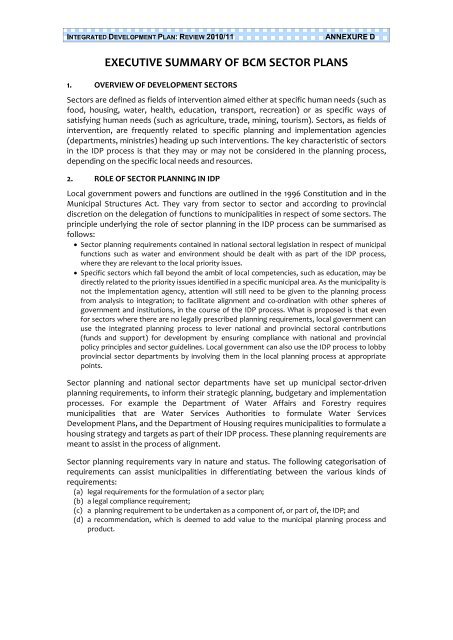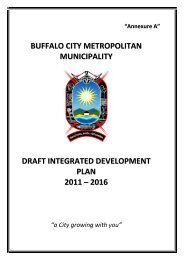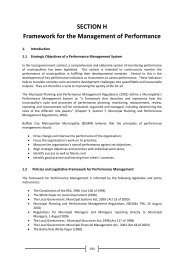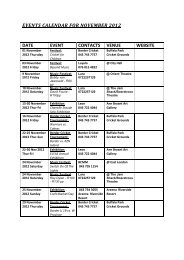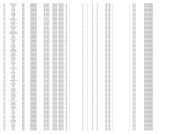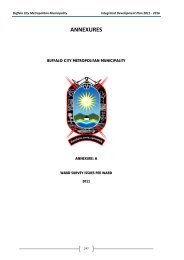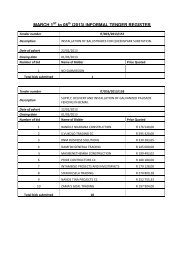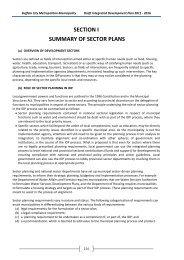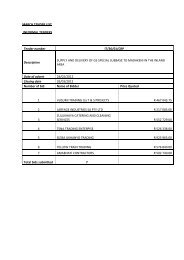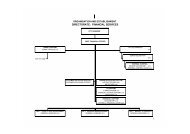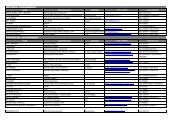annexure d executive summary of bcm sector plans - Buffalo City
annexure d executive summary of bcm sector plans - Buffalo City
annexure d executive summary of bcm sector plans - Buffalo City
Create successful ePaper yourself
Turn your PDF publications into a flip-book with our unique Google optimized e-Paper software.
INTEGRATED DEVELOPMENT PLAN: REVIEW 2010/11ANNEXURE DEXECUTIVE SUMMARY OF BCM SECTOR PLANS1. OVERVIEW OF DEVELOPMENT SECTORSSectors are defined as fields <strong>of</strong> intervention aimed either at specific human needs (such asfood, housing, water, health, education, transport, recreation) or as specific ways <strong>of</strong>satisfying human needs (such as agriculture, trade, mining, tourism). Sectors, as fields <strong>of</strong>intervention, are frequently related to specific planning and implementation agencies(departments, ministries) heading up such interventions. The key characteristic <strong>of</strong> <strong>sector</strong>sin the IDP process is that they may or may not be considered in the planning process,depending on the specific local needs and resources.2. ROLE OF SECTOR PLANNING IN IDPLocal government powers and functions are outlined in the 1996 Constitution and in theMunicipal Structures Act. They vary from <strong>sector</strong> to <strong>sector</strong> and according to provincialdiscretion on the delegation <strong>of</strong> functions to municipalities in respect <strong>of</strong> some <strong>sector</strong>s. Theprinciple underlying the role <strong>of</strong> <strong>sector</strong> planning in the IDP process can be summarised asfollows: Sector planning requirements contained in national <strong>sector</strong>al legislation in respect <strong>of</strong> municipalfunctions such as water and environment should be dealt with as part <strong>of</strong> the IDP process,where they are relevant to the local priority issues. Specific <strong>sector</strong>s which fall beyond the ambit <strong>of</strong> local competencies, such as education, may bedirectly related to the priority issues identified in a specific municipal area. As the municipality isnot the implementation agency, attention will still need to be given to the planning processfrom analysis to integration; to facilitate alignment and co-ordination with other spheres <strong>of</strong>government and institutions, in the course <strong>of</strong> the IDP process. What is proposed is that evenfor <strong>sector</strong>s where there are no legally prescribed planning requirements, local government canuse the integrated planning process to lever national and provincial <strong>sector</strong>al contributions(funds and support) for development by ensuring compliance with national and provincialpolicy principles and <strong>sector</strong> guidelines. Local government can also use the IDP process to lobbyprovincial <strong>sector</strong> departments by involving them in the local planning process at appropriatepoints.Sector planning and national <strong>sector</strong> departments have set up municipal <strong>sector</strong>-drivenplanning requirements, to inform their strategic planning, budgetary and implementationprocesses. For example the Department <strong>of</strong> Water Affairs and Forestry requiresmunicipalities that are Water Services Authorities to formulate Water ServicesDevelopment Plans, and the Department <strong>of</strong> Housing requires municipalities to formulate ahousing strategy and targets as part <strong>of</strong> their IDP process. These planning requirements aremeant to assist in the process <strong>of</strong> alignment.Sector planning requirements vary in nature and status. The following categorisation <strong>of</strong>requirements can assist municipalities in differentiating between the various kinds <strong>of</strong>requirements:(a) legal requirements for the formulation <strong>of</strong> a <strong>sector</strong> plan;(b) a legal compliance requirement;(c) a planning requirement to be undertaken as a component <strong>of</strong>, or part <strong>of</strong>, the IDP; and(d) a recommendation, which is deemed to add value to the municipal planning process andproduct.


